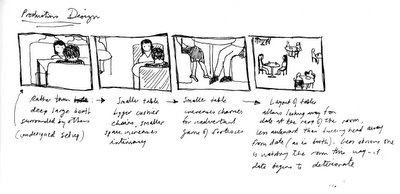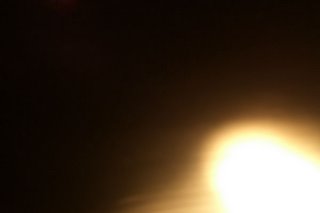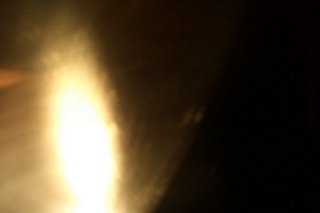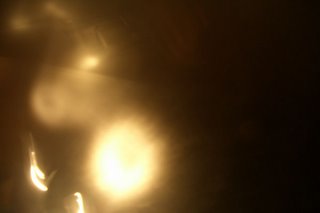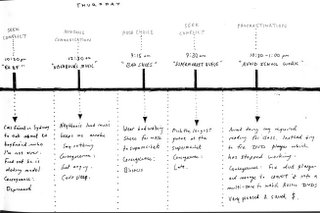DESIGNING EXPERIENCE
The Dinner Date - Part I
I am attempting to improve the design of a dinner date at the Red Fez restaurant. In order to do so, I had to analyse the pre-existing conditions that facilitated the problems that occured during this dinner date. Retrospective analysis allowed me to find connections between what these problems were, and how the 'design' of the restaurant contributed to these problems.
I realise the design of the eating experience at a restaurant involves
Pre-existing Design of Experience:
1) Waiting
2) Eating
3) Paying
The main problem I identified on this dinner date involved the first of these stages; the fact that my date and I were forced to wait for almost 90 minutes until we were seated, and secondarily (and worse), this wait was extremely stressful and uncomfortable for many reasons. I have tried to pinpoint how the design of the space created much of this tension.
Problems Incurred, and reason for:
1) We were told it would be a forty minute wait, it was ninety minutes [ill communication from staff]
2) Forced to stand next to door where there was no room [design of space]
3) Forced to stand over couple on a date themselves and watch them anxiously until they paid their bill [design of space]
4) Forced to stand over table where ex is having dinner with new girlfriend [design of space]
I noticed most the the problems with this experience derived from the design of the space within the restaurant; this actually created all the extremely awkward social interactions my date and I had to endure. I sketched out the space to pinpoint how this was actually occuring;

I isolated problem points in the space that were contributing both to our lengthy wait, and the awkwardness of this wait
1) The bar; the fact that the bar was used both for those waiting and those dining, while that did allow people to be served, it meant there was nowhere for people waiting to sit.
2) Passive aggressive slowness on the part of diners on a date themselves. Because my dinner date and I were forced to stand over these people, I suspect they were deliberately slow in eating and paying their bill. Also, this was a booth for six being occupied by two people.
3) This congestion area was an awful place to wait in. Apart from standing over people (see above), we were in the way of the waiters who kept pushing past to carry food upstairs.
4) This area between outside and inside was too small to wait in, and had no seating anyway.
Other factors were contributing to the lengthy wait; a slow kitchen, poor communication on the part of the staff in telling us how long to wait, and the fact that the place was full because it was a holiday the next day. Still, I felt a simple re-design of the downstairs area would at least make this wait less awkward and tense. Here is my new and improved setting for my dinner date:

The changes addressed the above-mentioned problems in the design of the space;
1) Turn the bar into a waiting area only - allows people to sit and drink while they wait.
2) Passive aggressiveness cannot be remedied, but helped by above design change - waiting customers do not have to stand over those dining. The previous situation was fundamentally flawed; my own experience (date) beginning wsa contingent on the these diners' experience ending - they knew it and we knew it. Separation between diners and waiting customers solves this.
3) Moving this table creates a bigger space to stand in. Also creates a larger passageway for servers to move through to carry food upstairs. Also, creating a stairwell at the back of the restaurant for staff means they don't have to walk past front of restaurant to current stairs.
4) Create some seating in this wasted space.
My design solution involved demarcating space more appropriately. The merging of waiting/dining space diminished both experiences for all parties involved. My date and I were awkward standing in the way and unable to really chat, and diners were being watched over and rushed through their dining experience. Simply defining a waiting area and dining area would be a simple solution.
The Dinner Date - Part I
I am attempting to improve the design of a dinner date at the Red Fez restaurant. In order to do so, I had to analyse the pre-existing conditions that facilitated the problems that occured during this dinner date. Retrospective analysis allowed me to find connections between what these problems were, and how the 'design' of the restaurant contributed to these problems.
I realise the design of the eating experience at a restaurant involves
Pre-existing Design of Experience:
1) Waiting
2) Eating
3) Paying
The main problem I identified on this dinner date involved the first of these stages; the fact that my date and I were forced to wait for almost 90 minutes until we were seated, and secondarily (and worse), this wait was extremely stressful and uncomfortable for many reasons. I have tried to pinpoint how the design of the space created much of this tension.
Problems Incurred, and reason for:
1) We were told it would be a forty minute wait, it was ninety minutes [ill communication from staff]
2) Forced to stand next to door where there was no room [design of space]
3) Forced to stand over couple on a date themselves and watch them anxiously until they paid their bill [design of space]
4) Forced to stand over table where ex is having dinner with new girlfriend [design of space]
I noticed most the the problems with this experience derived from the design of the space within the restaurant; this actually created all the extremely awkward social interactions my date and I had to endure. I sketched out the space to pinpoint how this was actually occuring;

I isolated problem points in the space that were contributing both to our lengthy wait, and the awkwardness of this wait
1) The bar; the fact that the bar was used both for those waiting and those dining, while that did allow people to be served, it meant there was nowhere for people waiting to sit.
2) Passive aggressive slowness on the part of diners on a date themselves. Because my dinner date and I were forced to stand over these people, I suspect they were deliberately slow in eating and paying their bill. Also, this was a booth for six being occupied by two people.
3) This congestion area was an awful place to wait in. Apart from standing over people (see above), we were in the way of the waiters who kept pushing past to carry food upstairs.
4) This area between outside and inside was too small to wait in, and had no seating anyway.
Other factors were contributing to the lengthy wait; a slow kitchen, poor communication on the part of the staff in telling us how long to wait, and the fact that the place was full because it was a holiday the next day. Still, I felt a simple re-design of the downstairs area would at least make this wait less awkward and tense. Here is my new and improved setting for my dinner date:

The changes addressed the above-mentioned problems in the design of the space;
1) Turn the bar into a waiting area only - allows people to sit and drink while they wait.
2) Passive aggressiveness cannot be remedied, but helped by above design change - waiting customers do not have to stand over those dining. The previous situation was fundamentally flawed; my own experience (date) beginning wsa contingent on the these diners' experience ending - they knew it and we knew it. Separation between diners and waiting customers solves this.
3) Moving this table creates a bigger space to stand in. Also creates a larger passageway for servers to move through to carry food upstairs. Also, creating a stairwell at the back of the restaurant for staff means they don't have to walk past front of restaurant to current stairs.
4) Create some seating in this wasted space.
My design solution involved demarcating space more appropriately. The merging of waiting/dining space diminished both experiences for all parties involved. My date and I were awkward standing in the way and unable to really chat, and diners were being watched over and rushed through their dining experience. Simply defining a waiting area and dining area would be a simple solution.
